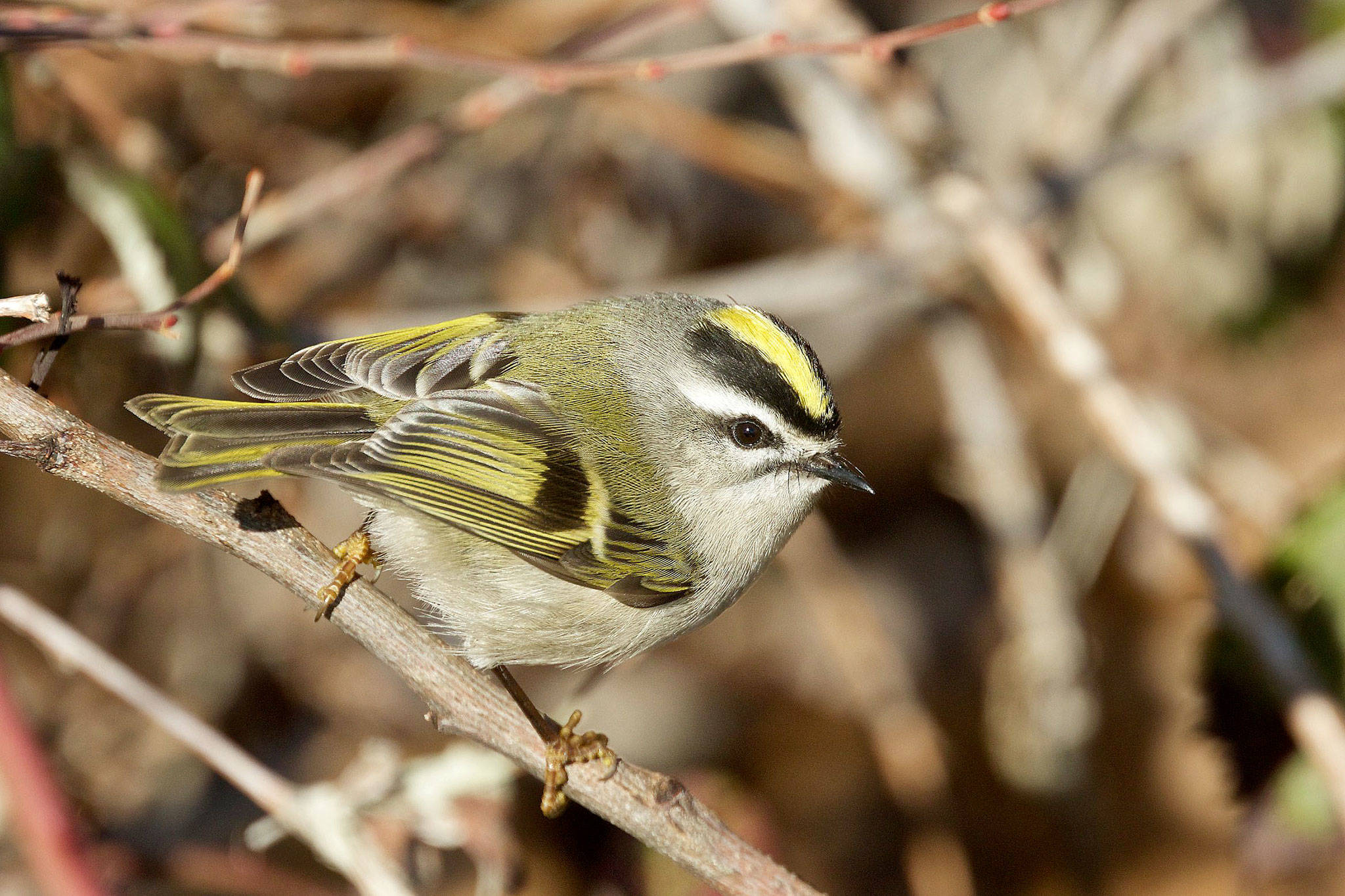By Dianna Moore
Grays Harbor Audubon
For those of us acknowledging the aging process, kinglets are a real challenge; we often can’t hear their high-pitched calls thanks to hearing issues, and have difficulties even finding these little bug-eaters thanks to their preference for the highest reaches of our firs and spruce trees. To add insult to injury, they are very active, scarcely stopping to let us see them. But they are worth the effort if one just has the patience to sit still and watch. A scope can help. Gregg Thompson was patient for several days, dodging small branches and dealing with a washed out sky. We think it was worth the effort.
Generald description: Golden-crowned Kinglets are small and round, barely much bigger than a hummingbird. They have boldly-marked heads, short wings, and a skinny tail, with a thick black stripe over their eyebrow and a bright lemon-colored stripe of feathers on top of their head which they can elevate like a Mohawk cut in an aggression display. Both sexes are 3.1 to 4.3 inches long, with a wingspan of 5.5 to 7.1 inches, and weighing approximately 0.1 to 0.3 ounces.
Habitat: Both kinds of kinglets (Golden-crowned and Ruby-crowned) are found year-round in Washington state, but only the Golden-crowned seems to thrive in the cold. Able to tolerate temperatures as low as -40 degrees F, this hyper-active bird can be seen in large groups of mixed flocks of like-sized birds, including warblers. They are common to lowland deciduous woodlands, orchards, Ponderosa pine forests, and along tree-lined streams, though they tend to prefer conifers. They breed in dense fir and spruce forests with closed canopies.
Behavior: Because of their tendency to join other birds with the same feeding habits, kinglets are easier to find in the winter. They are almost always found in very large flocks of birds, either gleaning bugs from the leaves while hovering in place, or even hanging upside down from a clump of needles. . They also fly out to catch tiny, flying insects. Their flight is quick and fluttery, and they frequently flick their wings. In winter and on migration they often forage much lower.
Diet: Golden-crowned Kinglets are insect-eaters, preferring the soft-bodied arthropods and their eggs from the undersides of leaves and the base of needles. They will eat grasshoppers, springtails, crickets, bees and wasps, spiders, and some mollusks. In winter they also eat seeds, sap, and some fruit.
Nesting: The males establish and defend their territory with great aggression and much energy. They are monogamous but form new pair bonds each breeding season. Both sexes build a deep nest as much as 50 ft up in a tree, usually a conifer, between two horizontal twigs and close to the truck. It is protected from above by an overhanging branch and made of moss, lichen, bark strips, twigs, and spider webs, and is lined with feathers, plant down, rootlets, and hair. Females incubate large clutches of 8 to 9 eggs and sometimes as many as 11 for about two weeks while the male brings food. She then broods the young for 3 to 5 days after they hatch, then joins the male to help feed the brood. The young leave the nest 16 to 19 days after hatching. The male continues to feed the young from the first brood for another 12 to 16 days while the female begins a second clutch.
Migration: Washington kinglets are mostly on territory year-round, but some do migrate shorter distances, often vertically into the higher elevations in milder weather or down to lower elevations during the rest of the year.
Conservation status: Golden-crowned Kinglets have expanded their range into new areas in the northeastern United States, and the population appears stable across its range. Much of their breeding area is remote and has escaped most human impact. However, in other areas, including Washington, large sections of their former breeding grounds have been cleared. The Washington Christmas Bird Count records an increase in the numbers of wintering birds, but this may represent breeders from more remote areas north of Washington.
Where and when to find on Grays Harbor: In western Washington, the Golden-crowned Kinglet is one of the most common species of wet coniferous forests all the way to the outer coast. They are common year round in appropriate habitat, which can be a local park, your yard, or in one of our marine forests. Your best bet is to take a camp stool or chair into a likely spot and sit quietly, trying to listen for the high-pitched sound of a whole bunch of little birds. Try to avoid “warbler neck”, an uncomfortable ache in the back of your neck from the tension of holding your head so far back while looking at the tops of the trees. Good luck!


